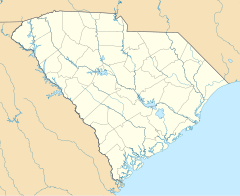Charleston Light

Charleston Light on Sullivan's Island
|
|
| Location | Sullivan's Island, South Carolina |
|---|---|
| Coordinates | 32°45′28.5″N 79°50′35.7″W / 32.757917°N 79.843250°WCoordinates: 32°45′28.5″N 79°50′35.7″W / 32.757917°N 79.843250°W |
| Year first constructed | 1960 |
| Year first lit | 1962 |
| Automated | 1975 |
| Foundation | Concrete |
| Construction | Steel with aluminum alloy skin |
| Tower shape | Triangular |
| Markings / pattern | Upper half black, lower half white |
| Height | 140 feet (43 m) |
| Focal height | 163 feet (50 m) |
| Original lens | DCB 24 |
| Current lens | DCB 24 |
| Range | 26 nautical miles (48 km; 30 mi) |
| Characteristic | Flashing white, 2 every 30 sec. |
| Fog signal | none |
| Admiralty number | J2646 |
| ARLHS number | USA-825 |
| USCG number |
3-195 |
3-195
Charleston Light on Sullivan's Island, South Carolina, which is the northern entrance to Charleston Harbor, was built to replace the defunct Morris Island Light on Morris Island. Construction was started in 1960, and it was first lit on June 15, 1962.
The lighthouse has a steel frame, an aluminum alloy skin, and a triangular cross section. It is 140 feet (43 m) tall. Built to withstand winds of 125 miles per hour, the focal plane of the light is 163 feet (50 m) above mean sea level. Originally painted white and red-orange, it is now a black upper half and white lower half. It is the only U.S. lighthouse with an elevator and air conditioning and was the last on shore manned lighthouse to be built by the Federal Government. The Texas Tower Offshore Lighthouses were truly the last manned lighthouses and, were built later starting in 1961 with Buzzards Bay Entrance Light.
It has a DCB 24 light. It originally had 28 million candelas (candlepower) and was the second most powerful in the Western Hemisphere. As the light was actually too dazzling, the power was lowered to 1.2 million candelas and could still be seen over 26 nautical miles (48 km; 30 mi). Its characteristic is two 0.2 s flashes separated by 4.8 s every 30 s. The light was automated in 1975.
It is a non-contributing resource located in the U.S. Coast Guard Historic District. Now part of Fort Sumter National Monument. Donated by the Coast Guard in 2007 to the National Park System. Although this lighthouse is still a working light, many problems inside this structure keeps it from being open to the public.
...
Wikipedia

